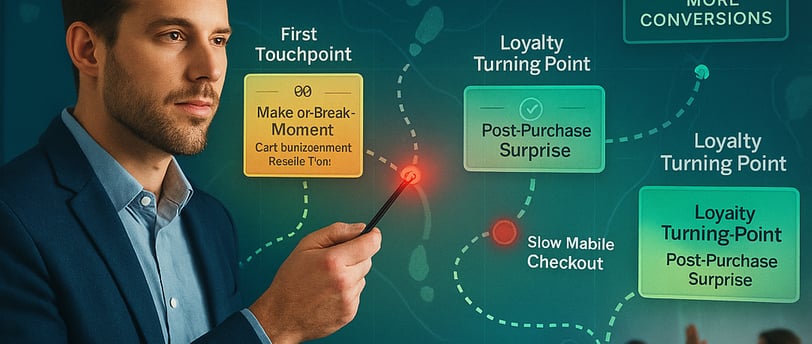The Role of Customer Journey Mapping in Optimizing Your Sales Funnel
Understand how customer journey mapping can help you identify pain points and opportunities in your sales funnel, leading to higher conversions and customer satisfaction.
MARKETING AUTOMATION
6/3/20253 min read


Introduction
In the competitive world of e-commerce, understanding your customers is the key to success. But how do you truly know what your customers are thinking, feeling, and experiencing as they interact with your brand? This is where customer journey mapping comes in.
Customer journey mapping is a powerful tool that allows you to visualize the entire customer experience, from the first touchpoint to post-purchase interactions. By identifying pain points, optimizing touchpoints, and creating a seamless journey, you can significantly improve your sales funnel’s performance and boost conversions.
In this article, we’ll explore what customer journey mapping is, why it’s essential for your e-commerce business, and how to create and use a customer journey map to optimize your sales funnel.
What is Customer Journey Mapping?
A customer journey map is a visual representation of the steps a customer takes when interacting with your brand. It includes every touchpoint, from discovering your products to making a purchase and beyond. The goal is to understand the customer’s experience, emotions, and pain points at each stage of their journey.
A well-crafted customer journey map helps you:
Identify gaps and inefficiencies in your sales funnel.
Understand your customers’ needs, preferences, and behaviors.
Create a more personalized and engaging shopping experience.
Improve customer satisfaction and loyalty.
Why is Customer Journey Mapping Essential for Your Sales Funnel?
Your sales funnel is only as effective as the customer experience it delivers. Here’s why customer journey mapping is crucial for optimizing your funnel:
Identify Pain Points: Discover where customers are dropping off or facing challenges in the buying process.
Optimize Touchpoints: Improve interactions at every stage of the journey to create a seamless experience.
Enhance Personalization: Use customer insights to deliver tailored content, offers, and recommendations.
Increase Conversions: Address friction points and make it easier for customers to complete their purchases.
Build Loyalty: Create a positive experience that encourages repeat business and word-of-mouth referrals.
How to Create a Customer Journey Map
Creating a customer journey map involves understanding your customers’ behaviors, emotions, and interactions with your brand. Here’s a step-by-step guide:
Step 1: Define Your Customer Personas
Start by creating detailed customer personas that represent your target audience. Include demographics, preferences, pain points, and buying behaviors.
Example Persona:
Name: Sarah
Age: 32
Occupation: Marketing Manager
Pain Points: Limited time for shopping, concerns about product quality
Goals: Find high-quality products quickly and easily
Step 2: Map the Customer Journey Stages
Break down the customer journey into key stages, such as:
Awareness: The customer discovers your brand.
Consideration: The customer evaluates your products.
Purchase: The customer makes a buying decision.
Retention: The customer becomes a repeat buyer.
Step 3: Identify Touchpoints
List all the touchpoints where customers interact with your brand, such as:
Social media ads
Website visits
Email campaigns
Customer support interactions
Post-purchase follow-ups
Step 4: Analyze Customer Emotions and Pain Points
At each touchpoint, consider how the customer feels and what challenges they might face. For example:
Awareness Stage: Are your ads compelling enough to grab attention?
Consideration Stage: Is your product information clear and detailed?
Purchase Stage: Is the checkout process smooth and hassle-free?
Retention Stage: Are you following up effectively to encourage repeat purchases?
Step 5: Visualize the Journey
Create a visual map that outlines the customer journey, including touchpoints, emotions, and pain points. Use tools like Lucidchart, Miro, or even a simple spreadsheet to bring your map to life.
How to Use Customer Journey Mapping to Optimize Your Sales Funnel
Once you’ve created your customer journey map, it’s time to use it to improve your sales funnel. Here’s how:
Address Pain Points: Identify and fix issues that cause friction or frustration for customers. For example, simplify your checkout process or improve your website’s mobile experience.
Enhance Touchpoints: Optimize interactions at every stage of the journey. For example, use personalized email campaigns to nurture leads or add live chat support to answer questions in real-time.
Personalize the Experience: Use customer data to deliver tailored content, offers, and recommendations. For example, recommend products based on browsing history or send birthday discounts.
Test and Iterate: Continuously monitor your funnel’s performance and make adjustments based on customer feedback and analytics.
Real-World Example: How Customer Journey Mapping Boosted Conversions for an E-commerce Brand
Let’s look at a real-world example of how customer journey mapping helped an e-commerce brand improve its sales funnel:
The Problem:
An online clothing store noticed a high cart abandonment rate during the checkout process.
The Solution:
By mapping the customer journey, they discovered that customers were frustrated by the lack of guest checkout options and unclear shipping costs.
The Results:
After implementing guest checkout and displaying shipping costs upfront, the store saw a 20% increase in conversions and a significant reduction in cart abandonment.
Conclusion
Customer journey mapping is a game-changer for e-commerce businesses. By understanding your customers’ experiences, emotions, and pain points, you can optimize your sales funnel, improve conversions, and build long-term loyalty.
Start creating your customer journey map today, and take the first step toward delivering a seamless and personalized shopping experience that drives results.
